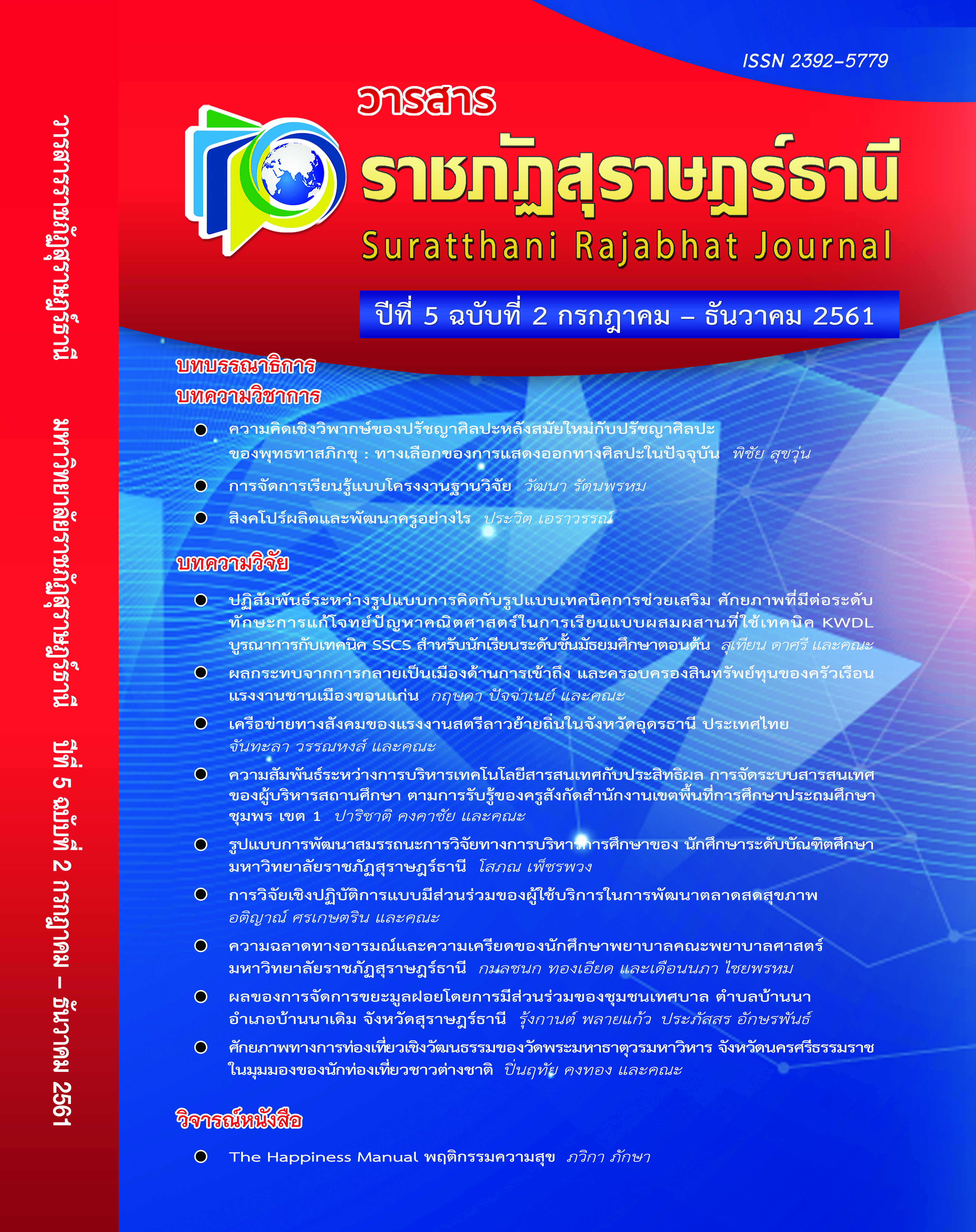The Analytical Concept between Philosophy of Postmodern Art and Philosophy of Art by BuddhadasaBhikkhu : An Alternative in Today’s Artistic Expression
Main Article Content
Abstract
This article aims to represent one of the current social issues of the reformation to various aspects of problems which we are experiencing nowadays and which urgently need to be solved. There are two trends in the art circle: first, the advent of philosophy of postmodern art and second, the philosophy of art by BuddhadasaBhikkhu. The aforementioned proposal for reformation happens by coincidence with the period when the academic study of art definitely needs a different way; changing from the past and the core of reformation is an explanation of what we call ‘art’, which should not be a rigid qualification any longer, but involve diversity, and equality. There is no conclusion and no adherence in things except the diversity and equality that eventually become the proposal to dismantle the traditional belief in art. This proposal is a direct link between the role of art and living, which means art is the thing that man is able to contemplate, develop and define by himself. This vision of art is extensively connected with both life and social development and it must be open for reinterpretation of the word, ‘art’ in order to make it more valuable. Thus, there is agreement between these two kinds of philosophy and such similar opinions are currently aligned with the reformation of various knowledge dimensions.
Article Details
References
กีรติ บุญเจือ. (2545). ปรัชญาหลังสมัยใหม่แนวคิดเพื่อการศึกษาแผนใหม่. กรุงเทพฯ : ดวงกมล.
______. (2546). ปรัชญาประสาชาวบ้าน. กรุงเทพฯ : ฐานบัณฑิต.
______. (2546ก). ปรัชญาอรรถปริวรรตของมนุษยชาติ. กรุงเทพฯ : ฐานบัณฑิต.
ชลูด นิ่มเสมอ. (2553). องค์ประกอบศิลปะ. กรุงเทพฯ : อมรินทร์.
ดำรง วงอุปราช. (2549). ศิลปะและคนของโลก. ใน ศิลปะวิชาการ 2 รวมข้อเขียนของศิลปินแห่งชาติ ศิลปิน และนักวิชาการศิลปะ เพื่อหาความหมายและคุณค่าศิลปะ หน้า 180-195. วิบูลย์ ลี้สุวรรณ บรรณาธิการ. กรุงเทพฯ : วิสคอมเซ็นเตอร์.
ธีรยุทธ บุญมี. (2546). ความหลากหลายของชีวิต ความหลากหลายทางวัฒนธรรม. กรุงเทพฯ : สายธาร.
พิชัย สุขวุ่น. (2559). ปรัชญาศิลปะหลังสมัยใหม่กับปรัชญาศิลปะในทรรศนะของพุทธทาสภิกขุ : การวิเคราะห์เชิงเปรียบเทียบเพื่อเสนอกระบวนทรรศน์ใหม่ทางศิลปะ และกระบวนทรรศน์แห่งการพัฒนาบนฐานของความหลากหลาย. สุราษฎร์ธานี : มหาวิทยาลัยราชภัฏสุราษฎร์ธานี.
พุทธทาสภิกขุ. (2508). ภาพพุทธประวัติจากหินสลักยุคก่อนมีพระพุทธรูป. กรุงเทพฯ : ธรรมสภา.
_______.(2535). ชุมนุมปาฐกถาชุดพุทธธรรม. กรุงเทพฯ : สุขภาพใจ.
_______.(2537). ไกวัลยธรรม ฉบับย่อ. กรุงเทพฯ : พิมพ์ดี.
_______.(2542). สัมมันตานุภาพ. กรุงเทพฯ : สุขภาพใจ.
_______.(2548). พุทธทาสลิขิตข้อธรรมบันทึก นึกได้เอง. กรุงเทพฯ : แปลนรีดเดอร์ส.
_______.(2549). ธรรมะกับการเมือง. กรุงเทพฯ : สุขภาพใจ.
_______.(2552). อิทัปปัจจยตา. กรุงเทพฯ : ไทยควอลิตี้บุคส์.
_______.(2556). จิตว่าง. กรุงเทพฯ : ธรรมสถาพร.
วิรุณ ตั้งเจริญ. (2547). ศิลปะหลังสมัยใหม่. กรุงเทพฯ : อีแอนด์ไอคิว.
สุภางค์ จันทวานิช. (2551). ทฤษฎีสังคมวิทยา. กรุงเทพฯ : จุฬาลงกรณ์มหาวิทยาลัย
สัมพันธ์ ก้องสมุทร. (2543). ศิลปินแห่งเซ็น ภิกษุอิมานูเอล เชอร์แมน. กรุงเทพฯ : สุขภาพใจ.
อานันท์ กาญจนพันธ์. (2552). คิดอย่างมิเชล ฟูโกต์ คิดอย่างวิพากษ์. เชียงใหม่ : มหาวิทยาลัยเชียงใหม่.
Marcel Duchamp Fountain. (2561). ภาพศิลปะลัทธิดาดา [ออนไลน์]. เข้าถึงได้จาก : https://www.bloggang.com/data/t/taiguy/picture/1254318456.jpg
[2561, มกราคม 3].


